The warm-mix asphalt (WMA) technology is used to effectively reduce construction temperatures by 20 to 30 ℃ for reclaimed asphalt pavements (RAP). It delays the short-term aging behavior of recycled asphalt binders and reduces the emission of pollutants during the construction process at high temperatures[1]. It is well known that asphalt binder aging is an irreversible process and it can significantly affect the pavement performance at both high and low temperatures[2]. The loss of volatiles and light chemical components during the aging process leads to the binder stiffening. The decrease of light chemical components and the increase of asphaltene content weaken the stress release ability of binders in low temperatures[3]. As a result, low-temperature cracking is easily caused[4]. Aging reduces the binder strain generated under the stress and improves the rutting resistance[5].
Using the WMA technology can cause an increase in the RAP content. Xiao et al.[6] reported that although increasing the RAP content improved the rutting resistance of asphalt binders but reduced the cracking resistance, the WMA additive could offset these properties. Sun et al.[7] evaluated the effects of different WMA additives on recycled asphalt binders with a high RAP content (30% to 70%). It was found that adding the WMA additive significantly lowered the rutting resistance and adding another one slightly improved it. However, adverse trends were found in terms of the low-temperature cracking resistance[8]. Kim et al.[9] also confirmed that the WMA additive type had a significant effect on the high and low temperature performance of the recycled binders.
The aging behavior of warm-mix recycled asphalt materials can be divided into two stages. The virgin binder experiences the initial aging process during the first newly constructed pavement service period. The secondary aging occurs during the recycled pavement service period[10]. Much research only focused on the pavement performance of the virgin binders during the initial pavement service period. However, the aging behavior of recycled binders during the secondary pavement service period is more complex. It is affected by the WMA technologies, rejuvenator additives, other additives, and the properties of the virgin binders[11]. The main purpose of this study is to evaluate the rutting and low-temperature cracking resistances of warm-mix recycled asphalt binders under the secondary aging condition. Effects of recycling plans and aging levels were investigated by the conventional physical properties test, dynamic shear rheometer (DSR) test, and bending beam rheometer (BBR) test. Aging and improvement mechanisms of the recycled binders were finally clarified by the Fourier transform infrared spectroscopy (FT-IR) test.
1 Experimental Plan
1.1 Materials
Five recycling plans are designed as shown in Tab.1. The styrene butadiene styrene (SBS) modified asphalt binder shown in Tab.2 was selected as the virgin binder for the laboratory aging simulation. The rejuvenator additive was used to recover the rheological properties of aged binders. Two types of WMA additives commonly used were selected to reduce the construction temperature and alleviate the aging effect. One was the surfactant-based Evotherm WMA additive. The other was the organic Sasobit WMA additive. Two types of other additives were also used to improve the pavement performance of the recycled binders. One is the styrene butadiene rubber (SBR) latex. The other is the crumb rubber powder (CRP). All additives used in the study are shown in Fig.1. Physical and chemical properties of various types of additives are provided in Tab.2. The optimum content values of various additives recommended from the existing study are used[10,12].
Tab.1 Recycling plans

PlanRecycled binder compositionAdditive content1RAP binder+Rejuvenator control Rejuvenator 4% of the RAP binder weight 2RAP binder+Rejuvenator+WMA Evotherm Evotherm 4% of the RAP binder weight 3RAP binder+Rejuvenator+WMA Sasobit Sasobit 3% of the RAP binder weight 4RAP binder+Rejuvenator+WMA Evotherm +SBR latexSBR latex 4% of the RAP binder weight 5RAP binder+Rejuvenator+WMA Evotherm +CRPCRP 18% of the RAP binder weight
Tab.2 Physical properties of asphalt binders
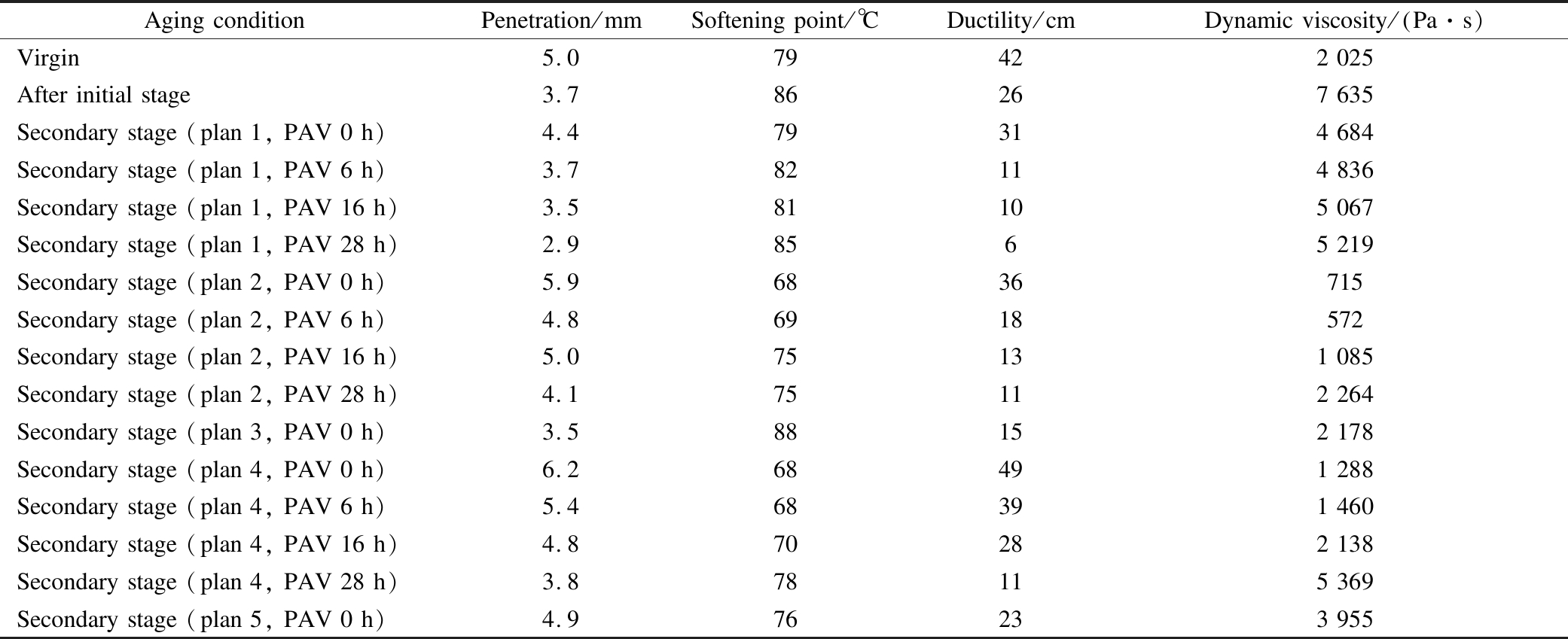
Aging conditionPenetration/mmSoftening point/℃Ductility/cmDynamic viscosity/ Pa·s)Virgin5.079422 025After initial stage3.786267 635Secondary stage (plan 1, PAV 0 h)4.479314 684Secondary stage (plan 1, PAV 6 h)3.782114 836Secondary stage (plan 1, PAV 16 h)3.581105 067Secondary stage (plan 1, PAV 28 h)2.98565 219Secondary stage (plan 2, PAV 0 h)5.96836715Secondary stage (plan 2, PAV 6 h)4.86918572Secondary stage (plan 2, PAV 16 h)5.075131 085Secondary stage (plan 2, PAV 28 h)4.175112 264Secondary stage (plan 3, PAV 0 h)3.588152 178Secondary stage (plan 4, PAV 0 h)6.268491 288Secondary stage (plan 4, PAV 6 h)5.468391 460Secondary stage (plan 4, PAV 16 h)4.870282 138Secondary stage (plan 4, PAV 28 h)3.878115 369Secondary stage (plan 5, PAV 0 h)4.976233 955

Fig.1 Appearance of additives
The aged SBS modified asphalt binder was firstly heated to 175 ℃ to reach the flow state. The WMA additive, if necessary, was added to the melted binder and stirred at the temperature of 140 ℃ for 10 min. Then, the rejuvenator additive was subsequently added and stirred for 10 min at the temperature of 170 ℃ for plan 1 and 140 ℃ for plans 2 to 5, respectively. The SBR latex or CRP, if necessary, was finally added and stirred for 30 min at the temperature of 140 ℃ to ensure uniformity. Five types of different recycled asphalt binders were completely fabricated according to the recycling plans.
1.2 Laboratory aging simulation procedure
Warm-mix recycled asphalt binders under different aging levels were produced by a two-stage simulation method[12]. At the initial stage, virgin binders were aged in turn by the rolling thin film oven test (RTFOT) at the temperature of 163 ℃ for 85 min and by the pressure aging vessel (PAV) at the temperature of 100 ℃ and the pressure of 2.1 MPa for 20 h, which simulated the first service period of 12 years before recycling. After recycling, recycled binders were aged again by RTFOT and PAV, following the similar procedure. The PAV aging durations of 0, 6, 16 and 28 h at the secondary stage were used to simulate the next service periods of 0, 1, 2, and 3 years, respectively[12].
1.3 Binder performance tests
The Penetration (25 ℃), softening point, ductility (10 ℃), and dynamic viscosity (60 ℃) of warm-mix recycled asphalt binders under different aging levels were measured according to the Chinese specification JTG E20—2011[13]. The strain-controlled DSR test was performed to measure the rheological properties of different asphalt binders according to the AASHTO specification[14]. The complex shear modulus |G*| and phase angle δ were measured at five different temperatures (58, 64, 70, 76 and 82 ℃). The range of loading frequencies was 0.1 to 30 Hz at a given temperature. The 25 mm parallel plates with the gap distance of 1.0 mm were used. The modified rutting factor |G*|(sinδ)-9 was used to evaluate the rutting resistance since it can fully take into account the effects of the delayed elastic deformation for modified binders[15]. The controlled strain for aged binders was 10%. The BBR test was conducted at the temperature of -12 ℃ to measure the low temperature performance of different asphalt binders in accordance with the ASTM specification[16]. The asphalt binder beam (125 mm × 12.5 mm× 6.25 mm) placed on two steel supports was subjected to a 980 mN creep load at the midspan for 240 s. The creep stiffness S and creep rate m were determined at the loading time of 60 s to evaluate the deformability and stress relaxation capability.
1.4 FT-IR test
Organic functional groups generally have specific absorption frequencies under the irradiation of infrared light waves. The nondestructive FT-IR test was performed to detect changes of functional groups for warm-mix recycled asphalt binders under different aging levels. A small amount of potassium bromide was first ground into powders to produce pressed samples. Then, the heated asphalt binder was evenly painted on the potassium bromide pressed samples. Infrared absorption spectra of different recycled asphalt binders were measured in the wavelength range of 400 to 4 000 cm-1 using an Alpha FT-IR manufactured by the Brüker Corporation. The attenuated total reflection mode was used. The OPUS software was used to process the infrared spectra.
2 Results and Discussion
2.1 Physical properties
The physical properties of the recycled binders under different aging levels are provided in Tab.2. Adding the rejuvenator additive (plan 1) partially recovers the physical properties of initially aged binders just after recycling (PAV 0 h). The two WMA technologies show distinctly opposite effects. The Evotherm technology (plan 2) significantly softens recycled binders. However, the Sasobit technology (plan 3) conversely makes them much harder. Using both SBR latex (plan 4) and CRP (plan 5) can further stiffen recycled binders combined with the Evotherm WMA additive, especially CRP. With the deepening of the secondary aging, penetration and ductility of recycled binders keep decreasing while the softening point and viscosity keep increasing, regardless of the recycling plans. At the secondary stage, the aging process shows an obvious acceleration as expected[17]. The physical properties of the recycled binders fall to the level before recycling (after the initial stage) within a shorter time[10].
2.2 Rutting resistance
The results of the modified rutting factor |G*|(sinδ)-9 for the recycled binders just after recycling (PAV 0 h) at different temperatures are shown in Fig.2. Results for recycled binders with CRP are taken as examples to show the effect of the secondary aging level on |G*|(sinδ)-9, as shown in Fig.3. It is found in Fig.2 and Fig.3 that |G*|(sinδ)-9 exponentially decreases with the temperature and linearly increases with the aging time. The secondary aging brings a positive effect on the rutting resistance. There is an increase of 68% to 378% in |G*|(sinδ)-9 after 28 h PAV aging for recycled binders with CRP. Compared with the control ones (plan 1), the recycled binders with plan 3 show a great increase of |G*|(sinδ)-9 by 4.6 to 5.6 times under different PAV aging times. The recycled binders with plan 5 show a greater increase by 7.1 to 13.3 times. For those recycled binders with plan 4, the increase of |G*|(sinδ)-9 also reaches 41% to 165%. This indicates that using CRP, Sasobit WMA additive, or SBR latex can improve the rutting resistance of recycled binders, especially the former two. The reason may be that CRP expansion by absorbing the resin and hydrocarbons increases the binder viscosity[18]. The crystallization of the Sasobit WMA additive and absorbed saturates below the melting point temperature may cause the loss of oil and wax, resulting in an increase of binder stiffness[19]. Asphalt molecules are twined and cut by the larger SBR molecules, which may hinder the flowing of asphalt binders and then improves their stability[20]. However, adding the Evotherm WMA additive may cause the deterioration of the rutting resistance due to the structural lubrication formed between the Evotherm WMA additive and asphalt binders[21]. Recycled binders with plan 2 show the reduction of |G*|(sinδ)-9 by 52% to 62%.

Fig.2 Effect of temperatures on |G*|(sinδ)-9

Fig.3 Effect of aging levels on |G*|(sinδ)-9 (plan 5)
According to the DSR test results, recycled binders with plans 3 to 5 were selected for calculating the high failure temperatures shown in Fig.4 and conducting the additional BBR test. It is observed in Fig.4 that recycled binders with plan 5 show higher failure temperatures of 14 to 26 ℃ than those with plans 3 and 4 under different PAV aging times. Compared those with plan 3, recycled binders with plan 4 show slightly lower failure temperatures under the secondary PAV aging time of 0 and 6 h and higher high failure temperatures under the secondary PAV aging time of 16 and 28 h. It is interesting that the high failure temperatures of recycled binders with plan 3 are independent on aging levels. It is inconsistent with the observation obtained from those with plan 5 shown in Fig.3. The reason may be that the Sasobit WMA additive is a typical waxy material and exhibits different physical states at different temperatures. It exists in a liquid state in the binder above the melting point temperature, which may substantially alleviate the binder stiffening caused by the aging effect[22].
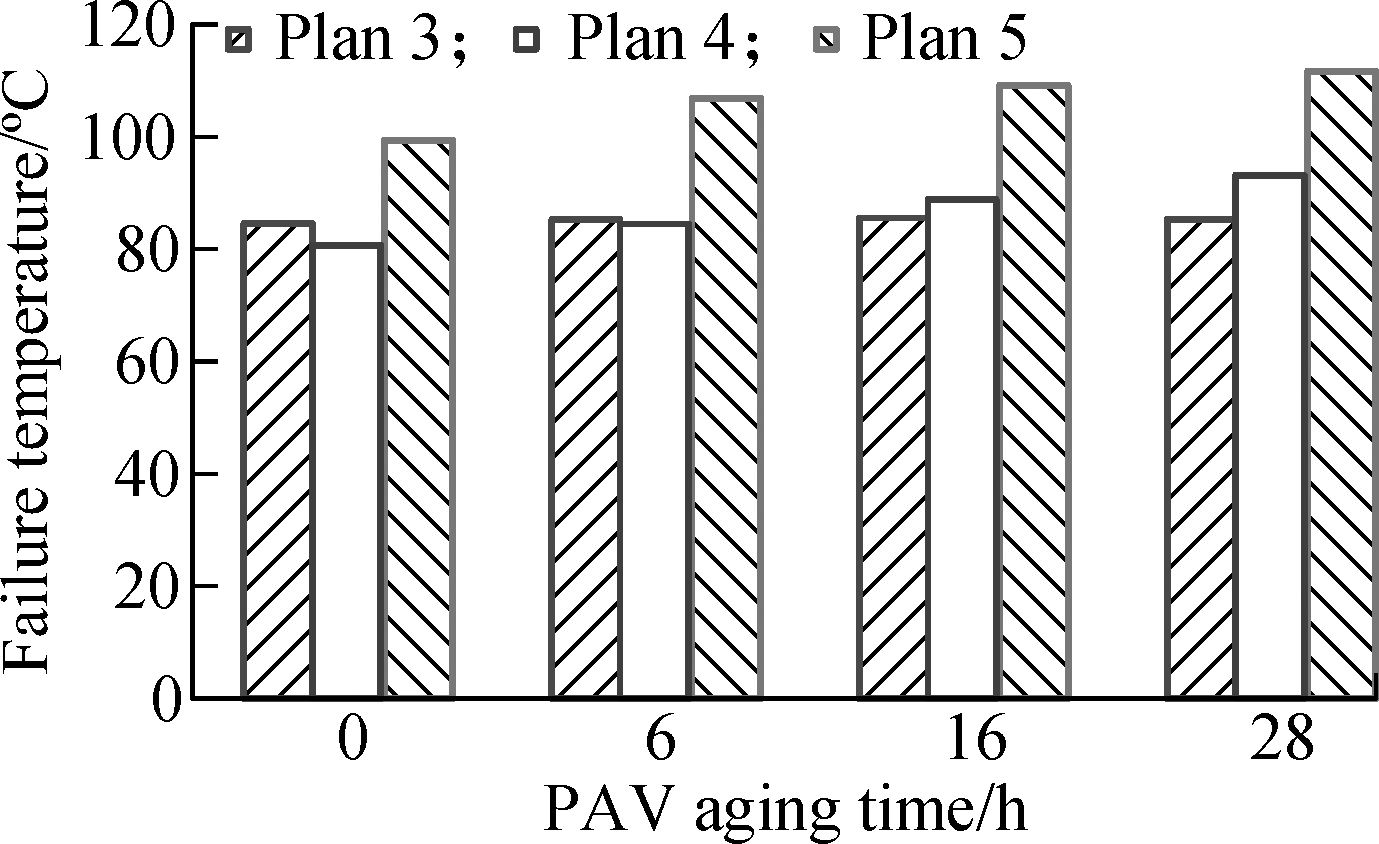
Fig.4 High failure temperatures of recycled binders
2.3 Low temperature cracking resistance
The S and m values of recycled binders with plans 3 to 5 at the temperature of -12 ℃ are shown in Fig.5 and Fig.6. Among all recycled binders, the ones with plan 3 exhibit the largest S values and the smallest m values. This reveals that using the Sasobit WMA additive may bring the potential low temperature cracking risk. Wax is the main constituent in the Sasobit WMA additive and it is dispersed in the asphalt binders after precipitation at low temperatures. It may destroy the integration degree among asphalt molecules and then cause the reduction of the cracking resistance[22]. The S and m values of recycled binders with plan 5 are 5% to 29% and 11% to 13% smaller than those with plan 4, respectively. It signifies that using CRP has a lower creep stiffness while using SBR latex shows a higher creep rate. CRP surface networks may absorb wax in the asphalt binders to reduce the temperature sensitivity and improve the low temperature cracking resistance[19]. Adding SBR latex may increase the content of light components in asphalt binders to improve their stress relaxation ability[20]. The secondary aging further plays a negative role in the low temperature cracking resistance of recycled binders. The S and m values linearly increase and decrease with the aging time regardless of recycling plans, respectively.
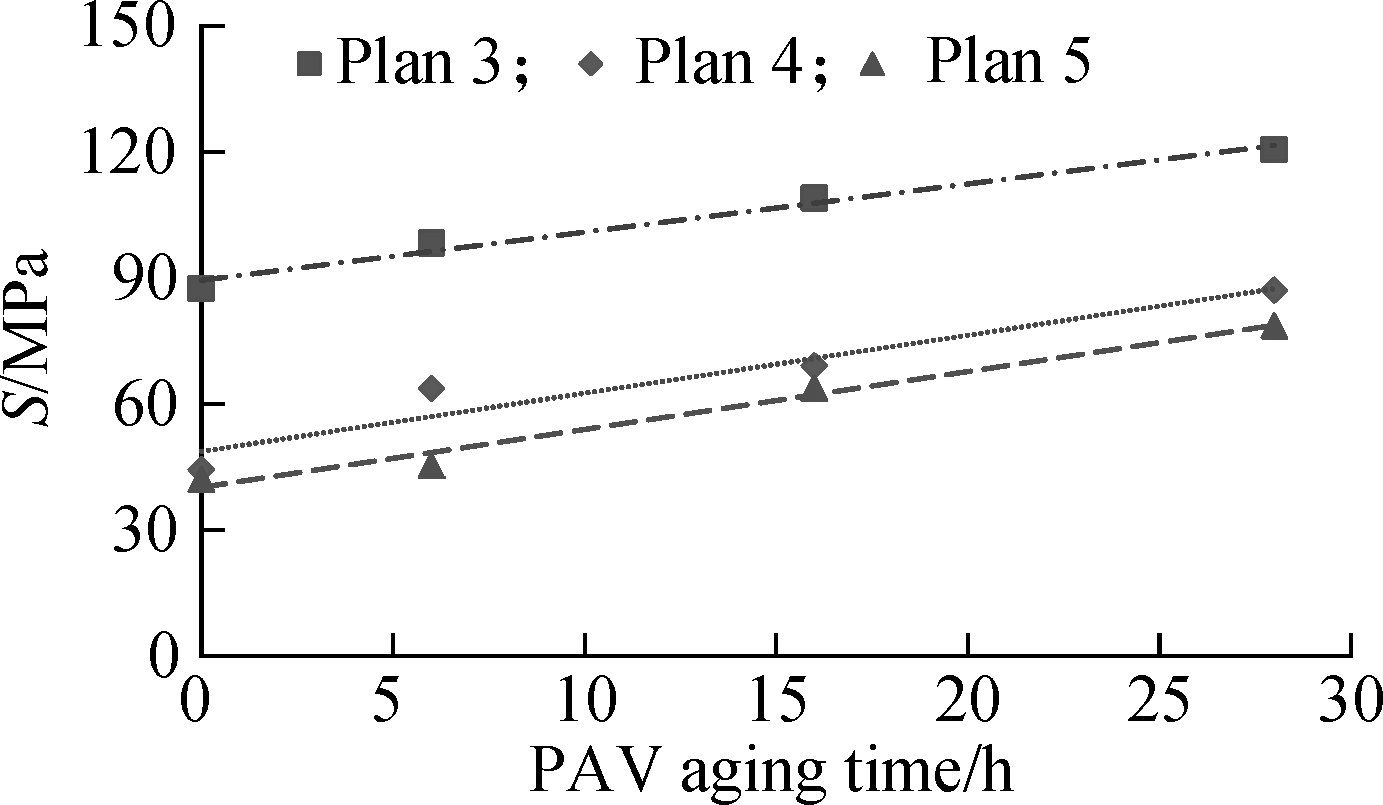
Fig.5 Effect of aging levels on S
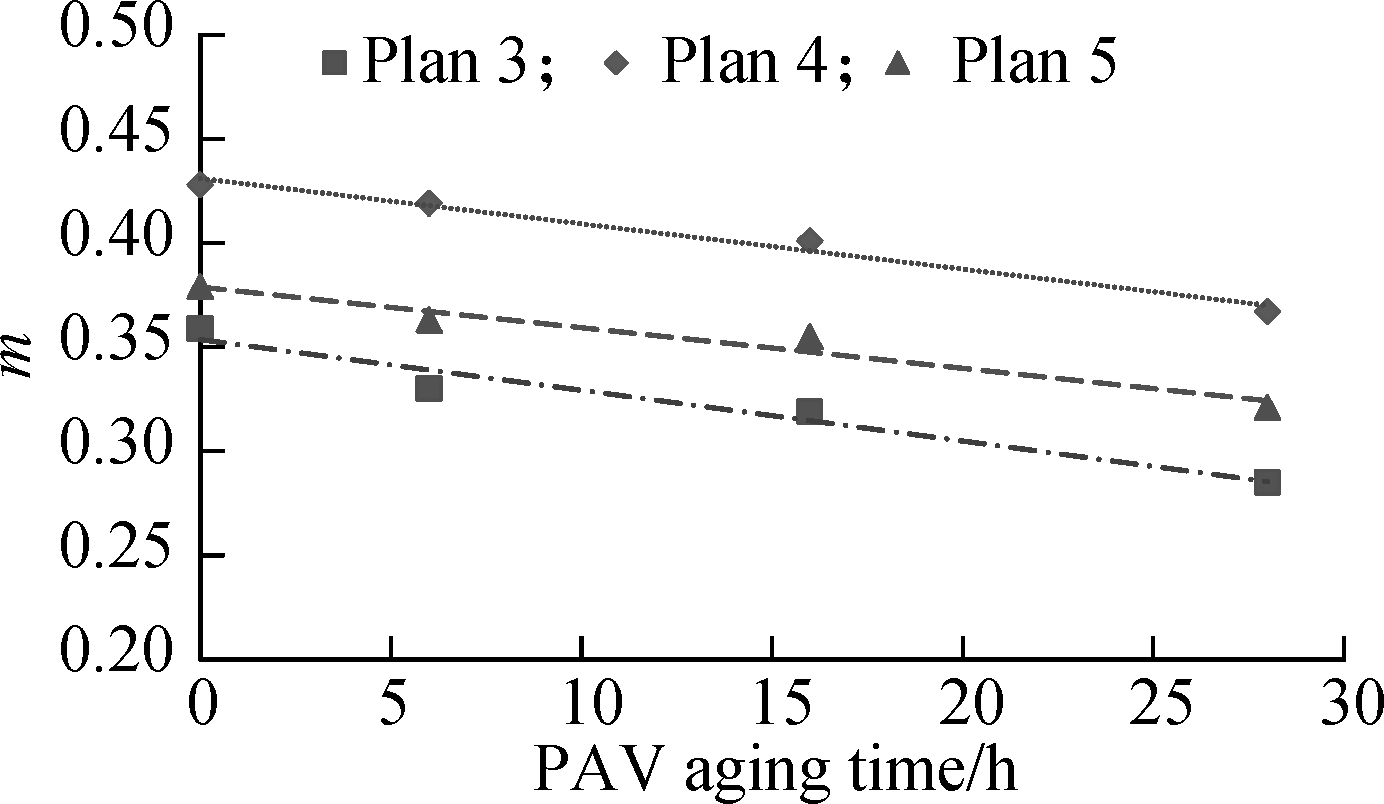
Fig.6 Effect of aging levels on m
The following Burgers model was used to fit the BBR test data to quantitatively evaluate the creep performance of recycled binders under different aging levels at a low temperature:
(1)
where γ is the shear strain; t is the creep time; τ0 is the constant shear stress; E1 is the elastic modulus of the Maxwell model; E2 is the elastic modulus of the Kelvin model; η1 is the viscosity of the Maxwell model; and η2 is the viscosity of the Kelvin model.
In the Burgers model, a smaller E1 means a higher ability for the elastic deformation. A smaller η1 expresses a higher ability for the viscous deformation. Smaller E2 and η2 signify a higher ability for the delayed recovery[23]. Regression coefficients of the Burgers model for recycled binders under different aging levels are shown in Tab.3. It is found in Tab.4 that all regression coefficients increase with the aging time regardless of recycling plans, indicating the continuous ability deterioration of the deformation and recovery for all recycled binders during the secondary aging process. Recycled binders with plan 3 always show the poorest ability for the deformation and recovery under a given aging level. On the contrary, those with plan 5 generally exhibit the best ability. One exception is that the recycled binder with plan 4 has the best ability for the viscous deformation (smallest η1) before the secondary aging (PAV aging 0 h). The reason may be that adding SBR latex can form the network structure in recycled binders at the early aging stage. However, the protection is lost gradually due to the pyrolysis of SBR latex along with the aging process[20].
Tab.3 Physical and chemical properties of additives

PropertyRejuvenatorEvotherm WMASasobit WMASBRCRPKinetic viscosity (60 ℃)/(mm2·s-1)58.7Dynamic viscosity (60 ℃)/(mPa·s)49.0Saturate content/%19.8Density/(g·cm-3)1.2040.9000.9201.260Amine value/(mg·g-1)519Solid content/%17.649.5pH9.17.17.6Size/mm0.6
Tab.4 Regression coefficients of Burgers model

PlanPAV aging time/hE1/kPaE2/kPaη1/(kPa·s)η2/(kPa·s)30271.8202.633 560.27 102.36273.6214.438 626.17 187.416274.7216.539 174.27 231.428280.1247.248 502.47 096.140150.790.79 969.03 259.06172.0101.915 152.94 025.616183.2110.317 674.14 484.928235.1162.525 158.95 617.450118.774.611 925.92 592.46120.380.212 851.02 745.216121.985.813 776.12 898.028173.8110.320 469.34 030.5
2.4 FT-IR spectra
The FT-IR spectra of asphalt binders under different aging levels are shown in Fig.7. It is found that absorption peaks at 876 to 722 cm-1 (![]() CH2 vibrations and swings in the benzene ring and in-plain swings of —(CH2)n—in alkyl groups)[21] decrease after the initial and secondary aging. It indicates that aromatic compounds in asphalt binders are lost. On the contrary, the absorption peak at 1 700 cm-1 (C
CH2 vibrations and swings in the benzene ring and in-plain swings of —(CH2)n—in alkyl groups)[21] decrease after the initial and secondary aging. It indicates that aromatic compounds in asphalt binders are lost. On the contrary, the absorption peak at 1 700 cm-1 (C![]() O stretching vibration in carbonyl groups)[24] increases. It signifies that hydroxy acids or ketones are produced. All these are the main characteristics of aging. Compared with the control one (plan 1), the recycled binder with the Sasobit WMA additive (plan 3) has larger absorption peaks at 722 cm-1 (mono-substituted benzene) and 700 cm-1 (polystyrene)[25]. The generation of some aromatic rings and polystyrenes aids the decrease of the binder viscosity during the construction and improves the rutting resistance during the pavement service period. Using SBR latex (plan 4) causes the increase of absorption peaks at 700 and 966 cm-1 (polybutadiene)[25].
O stretching vibration in carbonyl groups)[24] increases. It signifies that hydroxy acids or ketones are produced. All these are the main characteristics of aging. Compared with the control one (plan 1), the recycled binder with the Sasobit WMA additive (plan 3) has larger absorption peaks at 722 cm-1 (mono-substituted benzene) and 700 cm-1 (polystyrene)[25]. The generation of some aromatic rings and polystyrenes aids the decrease of the binder viscosity during the construction and improves the rutting resistance during the pavement service period. Using SBR latex (plan 4) causes the increase of absorption peaks at 700 and 966 cm-1 (polybutadiene)[25].
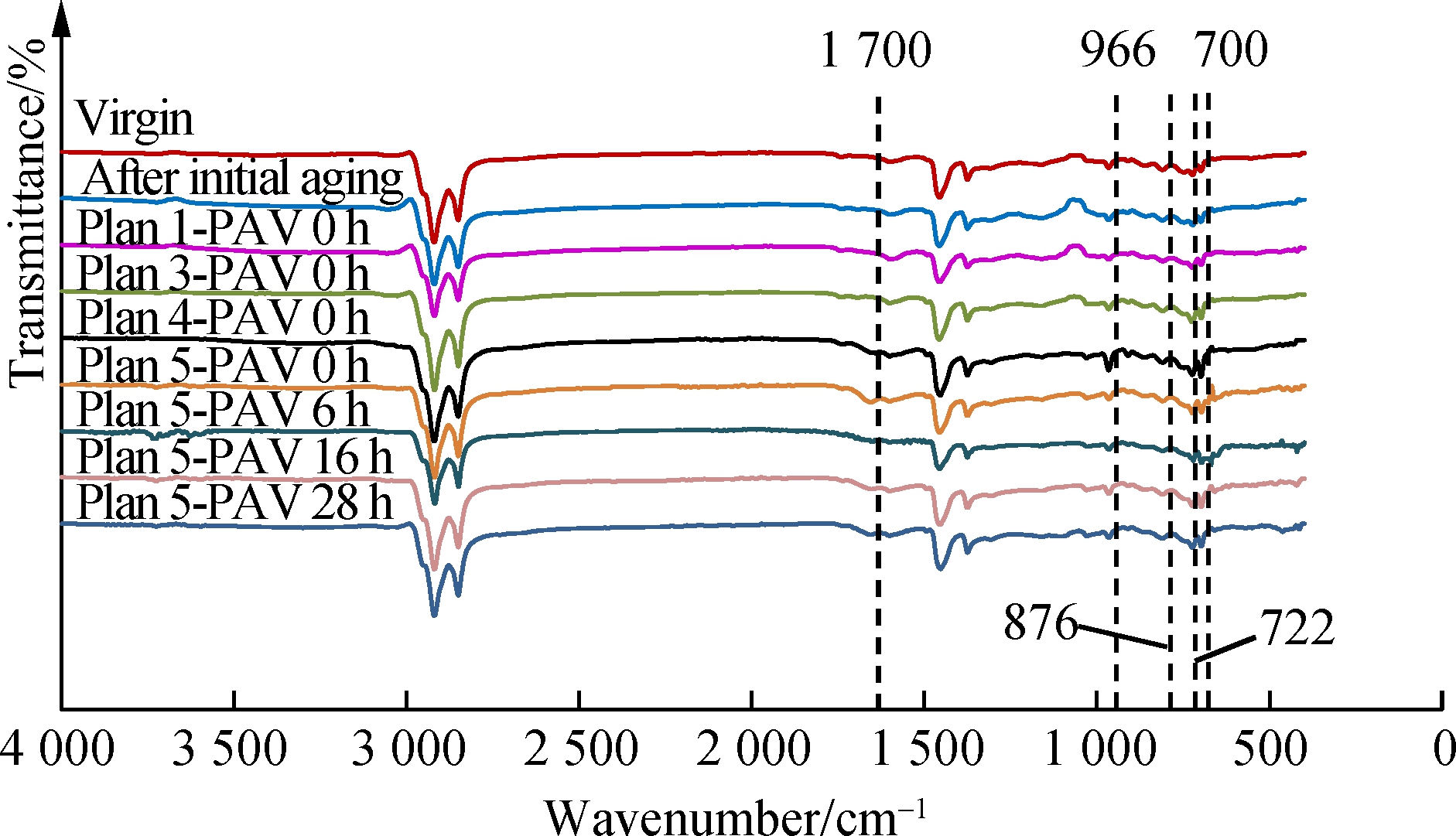
Fig.7 FI-TR spectra
The compensation of the SBS polymer pyrolysis after aging has a positive effect on improving both rutting and low temperature cracking resistances for recycled binders. Spectra do not show a significant change after adding CRP (plan 5) since it modifies binders by the physical adsorption and without the generation of new chemicals.
3 Conclusions
1) The secondary aging has a significant effect on the pavement performance of recycled asphalt binders even when using the WMA additive. It improves the rutting resistance while it reduces the low temperature cracking resistance.
2) Although using the Sasobit WMA additive in recycled asphalt binders can significantly improve the rutting resistance, it shows the poorest low temperature performance during the secondary aging process. Thus, it should be used with caution in cold regions.
3) Using SBR latex slightly improves the rutting resistance and greatly enhances the stress relaxation ability of warm-mix recycled asphalt binders. Using CRP can effectively improve both the rutting resistance and the ability to lower the temperature deformation and recovery.
4) The Evotherm WMA technology may have a rutting risk. It is recommended to use SBR latex or CRP with the Evotherm WMA additive to simultaneously improve the rutting and low temperature cracking resistances for recycled asphalt binders.
[1]Xia W J, Xu T, Wang H. Thermal behaviors and harmful volatile constituents released from asphalt components at high temperature[J]. Journal of Hazardous Materials, 2019, 373: 741-752. DOI:10.1016/j.jhazmat.2019.04.004.
[2]Chen J Y, Wang W Y, Sun Y R, et al. Performance evaluation and chemical property analysis of RWMA binders with 100% artificial reclaimed asphalt [J]. Journal of Southeast University (English Edition), 2017,33(1): 91-95.
[3]Yu X K, Zaumanis M, dos Santos S, et al. Rheological, microscopic, and chemical characterization of the rejuvenating effect on asphalt binders[J]. Fuel, 2014, 135: 162-171. DOI:10.1016/j.fuel.2014.06.038.
[4]Xu M, Yi J Y, Feng D C, et al. Diffusion characteristics of asphalt rejuvenators based on molecular dynamics simulation[J]. International Journal of Pavement Engineering, 2019, 20(5): 615-627. DOI:10.1080/10298436.2017.1321412.
[5]Chen Z X, Pei J Z, Wang T, et al. High temperature rheological characteristics of activated crumb rubber modified asphalts[J]. Construction and Building Materials, 2019, 194: 122-131. DOI:10.1016/j.conbuildmat.2018.10.223.
[6]Xiao F P, Putman B, Amirkhanian S. Rheological characteristics investigation of high percentage RAP binders with WMA technology at various aging states[J]. Construction and Building Materials, 2015, 98: 315-324. DOI:10.1016/j.conbuildmat.2015.08.114.
[7]Sun Y R, Wang W Y, Chen J Y. Investigating impacts of warm-mix asphalt technologies and high reclaimed asphalt pavement binder content on rutting and fatigue performance of asphalt binder through MSCR and LAS tests[J]. Journal of Cleaner Production, 2019, 219: 879-893. DOI:10.1016/j.jclepro.2019.02.131.
[8]Wang W Y, Chen J Y, Sun Y R, et al. Laboratory performance analysis of high percentage artificial RAP binder with WMA additives[J]. Construction and Building Materials, 2017, 147: 58-65. DOI:10.1016/j.conbuildmat.2017.04.142.
[9]Kim H, Lee S J, Amirkhanian S N, et al. Performance evaluation of recycled PMA binders containing warm mix asphalt additives [J]. Journal of Testing and Evaluation, 2011,39(4): 728-734. DOI:10.1520/JTE103116.
[10]Li Q, Zhang Z Y, Zhang S. Performance evaluation of warm-mix recycled asphalt binders after long-term aging [J]. Journal of Testing and Evaluation, 2019,47(4): 2889-2904. DOI: 10.1520/JTE20180157.
[11]Wang W Y, Chen J Y, Sun Y R, et al. Laboratory performance analysis of high percentage artificial RAP binder with WMA additives[J]. Construction and Building Materials, 2017, 147: 58-65. DOI:10.1016/j.conbuildmat.2017.04.142.
[12]Li Q, Li G F, Ma X, et al. Linear viscoelastic properties of warm-mix recycled asphalt binder, mastic, and fine aggregate matrix under different aging levels[J]. Construction and Building Materials, 2018, 192: 99-109. DOI:10.1016/j.conbuildmat.2018.10.085.
[13]Ministry of Transport of the People’s Republic of China. JTG E20—2011 Standard test methods for bitumen and bituminous mixtures for highway engineering [S]. Beijing: China Communications Press, 2011. (in Chinese)
[14]AASHTO. AASHTO M320 Standard specification for performance-graded asphalt binder[S]. Washington, DC, USA: American Association of State and Highway Transportation Officials, 2010.
[15]Chen H X, Wang B G. Modification of rutting factor of styrene butadiene styrene block copolymer modified-asphalt[J]. Journal of Tongji University (Natural Science), 2008, 36(10): 1384-1387, 1403. DOI:10.3321/j.issn:0253-374X.2008.10.014.(in Chinese)
[16]ASTM International. ASTM D6648 Standard test method for determining the flexural creep stiffness of asphalt binder using the bending beam rheometer (BBR) [S]. West Conshohocken, PA, USA: ASTM, 2016.
[17]Zhang J, Wang D M. Experiment on pavement performance of secondary hot in-place recycling asphalt mixtures[J]. Journal of China and Foreign Highway, 2017, 37(6): 283-287. (in Chinese)
[18]Ma T, Zhao Y L, Huang X M, et al. Characteristics of desulfurized rubber asphalt and mixture[J]. KSCE Journal of Civil Engineering, 2016, 20(4): 1347-1355. DOI:10.1007/s12205-015-1195-1.
[19]Ma X, Cui Y C, Liang C Z, et al. Effects of two kinds of modifier on surface morphology of asphalt[J]. Journal of Building Materials, 2017, 20(4): 569-574. (in Chinese)
[20]Li J. Research on hot in-place recycling technology for modified asphalt pavement[D]. Nanjing: Southeast University, 2016. (in Chinese)
[21]Yu X, Leng Z, Wei T Z. Investigation of the rheological modification mechanism of warm-mix additives on crumb-rubber-modified asphalt[J]. Journal of Materials in Civil Engineering, 2014, 26(2): 312-319. DOI:10.1061/(asce)mt.1943-5533.0000808.
[22]Jamshidi A, Hamzah M O, You Z P. Performance of Warm Mix Asphalt containing Sasobit®: State-of-the-art[J]. Construction and Building Materials, 2013, 38: 530-553. DOI:10.1016/j.conbuildmat.2012.08.015.
[23]Li G F, Wang H C, Wang Y, et al. Finite element analysis of steel bridge deck pavement rut based on modified Burgers model[J]. Journal of Forestry Engineering, 2016, 30(5): 120-125. DOI:10.13360/j.issn.2096-1359.2016.05.021.(in Chinese)
[24]Yu H Y, Leng Z, Zhou Z Y, et al. Optimization of preparation procedure of liquid warm mix additive modified asphalt rubber[J]. Journal of Cleaner Production, 2017, 141: 336-345. DOI:10.1016/j.jclepro.2016.09.043.
[25]Bernier A, Zofka A, Yut I. Laboratory evaluation of rutting susceptibility of polymer-modified asphalt mixtures containing recycled pavements[J]. Construction and Building Materials, 2012, 31: 58-66. DOI:10.1016/j.conbuildmat.2011.12.094.